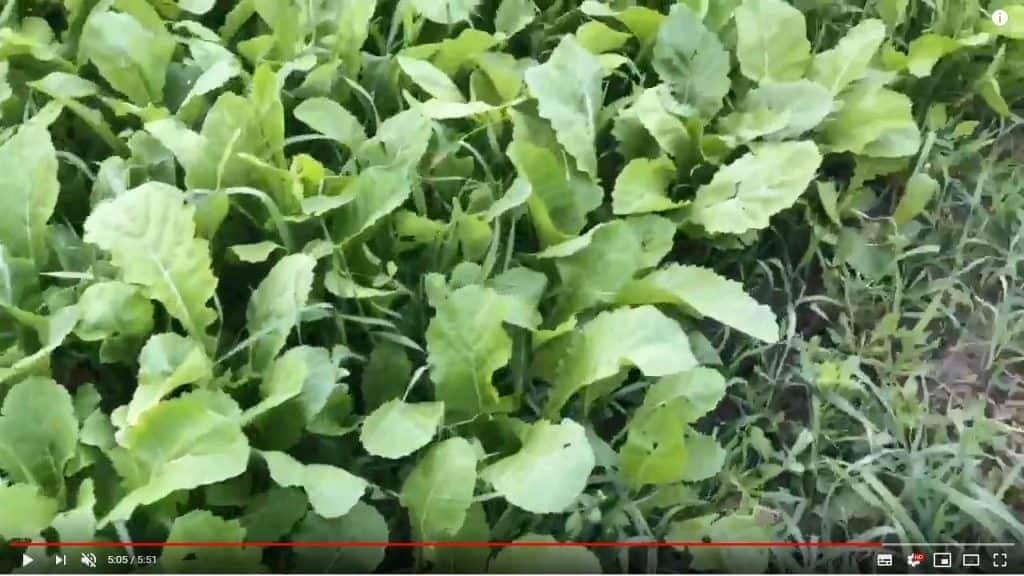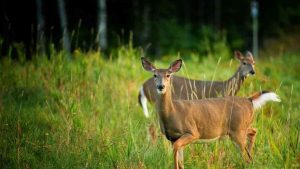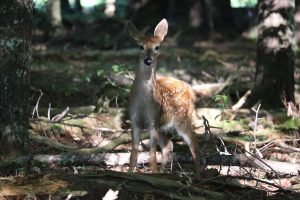It comes as no secret that deer follow their stomachs to wherever the highest quality food source in a given area can be found. What this food source is, often differs heavily from one portion of the year to the next. When the cold chill of winter arrives, there are few forages that attract deer as readily as turnips.
Turnips make a wonderful addition to any food plot, as they can be highly effective in attracting and holding deer on a property.
TL;DR
Turnips are a top cold-weather food source for deer due to their high protein and carb content. The bulb and leafy greens provide sustenance. Purple top turnips are ideal because the exposed bulb draws deer’s attention. Plant turnips in early fall about 90 days before your area’s first frost date, so plants reach maturity before freezing temps. This provides deer with nutrition through the winter. Turnips can attract deer to your hunting area and provide a diverse food source.
Contents (Jump to Topic)
When heavy winter frosts begin to occur, turnips quickly become one of the highest priority food sources for deer.
This stems from the fact that winter is the time of the year when wildlife finds turnips most palatable.
Why Would You Plant Turnips For Deer?
Deer rely solely upon browse for sustenance. When multiple food sources are available, deer will feed on the forage that is most palatable to them.
This is precisely why many hunters plant food plots on a yearly basis. By providing a pre-planted forage for deer to consume, a hunter boosts the attraction of the property they hunt.
Much of a food plot’s success, or lack thereof, often comes down to what seed varieties are planted within.
Most hunters and habitat managers strive to plant forage that is both nutritious and abundant in its yield. One type of forage that fits this bill perfectly is turnips.
Turnips belong to a family of forages known as brassicas. These leafy plants are typically quite cold hearty and can be grown in virtually any geographical location, north to south, east to west.
Other members of the brassica family include radishes, cauliflower, rape, and kale.
Turnips are high in both protein and carbohydrates, making them beneficial to wild deer during many stages of the year.
The protein yield of turnips generally falls into the 15-22% range, and their high natural sugar content provides deer with the carbohydrates they need to produce and retain body heat in the winter.
Another advantage of planting turnips in a food plot is that they are the gift that keeps on giving, providing deer a sustainable food source on two different fronts.
- During the early parts of the season, deer forage heavily on the leafy tops of turnips. These tops can be quite abundant, as a well-maintained plot will produce a yield of 6-8 tons per acre.
- In winter months, deer begin feeding heavily on the rooted bulb portion of turnips, as they begin to sweeten.
Signs of feeding activity within turnip food plots are easily identifiable in many regions, during the months of November through March.
The presence of freshly turned dirt and partially consumed turnip bulbs signal that the heaviest period of consumption has begun.
Purple Top Turnips
In the eyes of many deer hunters and land managers, one variety of turnip stands above the rest, the purple top turnip.

These hearty turnips offer the distinct advantage of being more readily consumed by deer than many other varieties, due to their position within the soil in which they are planted.
The top of a purple top turnip’s bulb protrudes slightly above the top of the soil, upon reaching maturity. This allows deer better access to the bulbs for consumption.
The exposed portion of bulb draws a deer’s attention substantially earlier than those of other turnip varieties, which remain completely concealed within the ground below.
This can be beneficial in areas where turnips are being planted for the first time. Many hunters have reported that deer are often reserved in their digging of turnips during their first year of being planted in many areas.
You can read more about top-notch wireless trail cameras here
The general consensus is that deer who have never encountered a turnip, simply do not know that such a food source is present below the soil’s surface.
Because of this, it often takes a deer’s coincidental discovery of the buried bulbs, for them to begin consuming the turnips in earnest.
This often occurs when a deer unintentionally pulls a bulb from the ground while attempting to consume the turnip’s green tops.
However, purple top turnips bypass much of this learning curve by providing deer with a visual clue of what lies below, in the form of the turnip variety’s protruding purple top.
This often results in heavy consumption of a newly planted annual turnip food plot, even in its initial year of planting.
When Should You Plant Turnips For Deer

Yet another advantage of planting turnips within a food plot is that they mature very quickly, in comparison to other species of forage. Turnips only take 70-90 days to reach peak maturity.
This is important to know because you will use this rate of time-to-maturity when figuring an approximate date for planting to commence.
Turnips, by nature, are a cool-season species. This means that they should typically only be planted in the fall of the year.
If turnips were to be planted in the spring, it is highly likely that summer heat and dry conditions would kill, or severely stifle your plot’s growth potential.
It is recommended that you do not plant your turnip plot until yearly temperatures are descending from their peak.
The period of time that spans the transition between summer and fall is ideal for planting. This avoids the summer sun’s relentless heat but also allows for plant maturity to be reached before freezing temperatures arrive.
To get a better idea regarding how fall brassica food plots are planted, check out this video.
What Has Cold Weather To Do With It?
When choosing when to plant a food plot, especially one that is to consist of turnips, it is of significant value to plant early enough in the fall to avoid exposing plants to freezing weather until they reach maturity.
This is where the 70-90 day maturity rate that we previously discussed, comes into effect.
To avoid young plants from suffering ill-effects due to cold temperatures, you must first figure out the average date of the year’s first frost in your area.
In most areas, if you are not aware of this exact date, you can locate it by studying weather records from previous years.
Once the average date of the year’s first frost in your area has been located, backtrack this date by three months. This date will be your latest possible safe planting date for your turnip food plot.
Planting any later than this will not allow a full 90-day window for the plants within your plot to mature before frost becomes likely.
Planting Turnips To Maximize Hunting Success
By planting turnips in your food plot this year, you will be providing deer in your area with a higher level of diversity in their diet, all the while grooming your hunting property to attract and hold more deer.
By choosing your planting dates carefully, and purchasing only the best turnip seed varieties available, you will maximize your food plot’s effectiveness, and bring deer from far and wide to feed on the fruits of your labor.
As always, feel free to leave any comments you might have, as we appreciate hearing from our readers.
FAQ
Why Would You Plant Turnips For Deer?
Deer rely solely upon browse for sustenance. When multiple food sources are available, deer will feed on the forage that is most palatable to them.
This is precisely why many hunters plant food plots on a yearly basis. By providing a pre-planted forage for deer to consume, a hunter boosts the attraction of the property they hunt.
What Has Cold Weather To Do With Planting Turnips For Deer?
When choosing when to plant a food plot, especially one that is to consist of turnips, it is of significant value to plant early enough in the fall to avoid exposing plants to freezing weather until they reach maturity.
This is where the 70-90 day maturity rate that we previously discussed, comes into effect.







2 thoughts on “Planting Turnips For Deer”
Growing turnips is a smart thing to consider, as these vegetables are high in protein and especially appetizing to these hoofed animals. The optimal time for this task is during early fall, though spring and summer are possible.
Choose a suitable location for your food plot. Look for an area with good soil quality and drainage. It’s essential to select a spot with adequate sunlight for turnip growth.